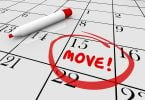You’d be hard pressed to find worse travelers than cats. Unlike your dog that jumps (literally!) at the chance for a car ride, a cat will usually take a pass. You can imagine how stressful a move can be on your furry feline. Make the move easier for all involved by gathering up a moving kit for “kitty”. Include the necessities, but don’t forget items to make the ride cushier and less scary. Read on to learn about the best way to assembling a moving kit for cats.
Secure Carrier or Crate
A cat on the loose in or outside a vehicle is a threat to herself and other drivers that might swerve to avoid her. Never travel with a cat without a secure carrier. Kitty will feel safer enclosed inside and the carrier should be large enough for ease of movement, but not too large that she will be jostled around inside.
Comfy Blanket or Crate Liner
Having your cat’s favorite blanket inside the carrier will make her feel safer and warm. Adding a waterproof material under a crate liner will make clean up easier in case of accidents.
Food, Water, and Treats
Cats tend to have nervous stomachs in strange settings, so don’t feed her much on moving day. But do bring enough food for the trip and time needed to settle into the new home. We don’t always see cats drinking water, but make it available at all times to prevent dehydration. During the actual move, it may be tricky to have a water dish in the carrier, so plan on giving her water frequently on stops.
Special treats are a nice idea for the trip but don’t be surprised if she ignores them while stressed.
Bowls and Water Containers
Don’t forget your cat’s food and water dishes. Either bottled water or water in your own container should be included in your kit. Water may not always be available at your rest stops.
Litter Box and Litter
Start kitty on a smaller, travel-size litter box before your move. Bring the box and her litter (the clumping type will be easiest to manage). Don’t forget a scoop, trash bags for disposal and some pet wipes. If you’re not keeping the litter box in the carrier, be sure to allow opportunities for her to use the box. She may be shy and not be on a “normal” schedule.
Collar with I.D. Tags
Even if your inside-only kitty doesn’t wear a collar, put one on her with an I.D. tag for the trip. A leash and harness should be included in case she needs to be restrained to prevent escape.
- Microchip: Always a good idea, a microchip is vital in a move. Inserted just under the skin by your vet, the chip has a unique I.D. that can be scanned if your cat is missing.
- Rabies tag: If your cat doesn’t wear a collar with her rabies vaccine tag, include a copy of the vaccine record in your kit.
Vet Contact and Health Records
Prior to your move, ask your veterinarian for a copy of your cat’s medical records. These should be in her kit when you’re in the midst of moving and will include your vet’s contact information. Even if the move means finding kitty a new vet, having a complete medical history and record of care is especially crucial if you’re in an accident or your cat has a health issue on the road.
Medications and Tranquilizers
It’s critical that you pack your kitty’s medications in the moving kit. Ask your vet for refills before you leave. If your cat is especially skittish, ask your vet about a mild sedative for the move. Ask questions about possible side effects and the proper dosage.
When moving with your canine friend, click here for a moving kit for dogs.








